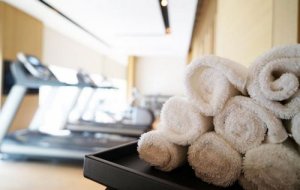The Most Common Gym Bacteria

Nowadays, going to the gym is a trend among people of all ages, because it’s good for your body. In addition, it helps you in other ways too; helping you to lose weight, tone muscles or simply live a healthier lifestyle. However, you should also know about the risks involved with visiting the gym. You can easily contract an infection due to the most common gym bacteria.
As with any public place, gyms are usually cleaned regularly, but it doesn’t mean that you won’t be exposed to the most common gym bacteria. It’s not an excuse to avoid the gym, but you should know how to protect yourself. In this article, we’ll take a look at the most common gym bacteria that you can encounter.
The Most Common Gym Bacteria
1. Athlete’s foot
Athlete’s foot is a foot infection that occurs due to different fungi. You can contract it by walking barefoot through a swimming hall, in showers, or in changing rooms.
Moreover, it’s one of the most common gym bacteria. In addition, it’s characterized by cracks in your skin and the appearance of flaky skin between or at the sides of your toes. There are cases where the symptoms can be much more serious.
Furthermore, indoor biking and running on the treadmill can make it worse if you perform these activities without proper footwear. Your toes and toenails can rub against your shoes and as a result, your toenails can rise, leaving them exposed to the potential fungus.
Also, there are antifungal and topical treatments you can use to treat athlete’s foot. Finally, to prevent it from appearing, make sure you always wear well-fitting shoes at the gym and keep your feet clean and dry.
2. Flu
Both the flu and cold viruses can survive on your skin for up to three hours and a maximum of four hours on other materials.
With the data we have, we’ve determined that this type of virus can appear in any gym where facilities and equipment are used regularly, by different people. For example, this includes treadmills, bicycles, and dumbbells.

Therefore, before using gym equipment always clean it, and don’t touch your mouth or nose while exercising. Finally, always wash your hands when you’ve finished your routine.
3. Staphylococcus Aureus
More commonly known as staphylococcus, it’s another common gym bacteria present in people, mainly on your skin and in your nose. What’s more, anyone with this infection can easily transmit it through skin-to-skin contact. These bacteria can be found on towels or exercise machines.
4. HPV
HPV is commonly known as the human papillomavirus, which can cause plantar warts. You can catch it through skin-to-skin contact or by walking barefoot in bathrooms and showers. To avoid one of the most common gym bacteria always wear flip-flops in these public areas.
5. Streptococcal bacteria
Streptococcus bacteria is very contagious and can be transmitted through skin-to-skin contact or gym equipment. In addition, this bacteria can cause streptococcal pharyngitis, skin infections, and blisters. Finally, to treat this infection, you’ll have to visit your doctor.

6. E. coli bacteria and hepatitis A
Though they might not be the most common gym bacteria, they’re present and transmitted through the fecal-oral route. It can be transmitted when someone doesn’t wash their hands after going to the bathroom. Then, the bacteria spreads to the next person who touches the same objects.
Finally, these types of bacteria often cause symptoms such as cramps, diarrhea, or vomiting. So, if you notice similar symptoms, visit your doctor as soon as possible.
Nowadays, going to the gym is a trend among people of all ages, because it’s good for your body. In addition, it helps you in other ways too; helping you to lose weight, tone muscles or simply live a healthier lifestyle. However, you should also know about the risks involved with visiting the gym. You can easily contract an infection due to the most common gym bacteria.
As with any public place, gyms are usually cleaned regularly, but it doesn’t mean that you won’t be exposed to the most common gym bacteria. It’s not an excuse to avoid the gym, but you should know how to protect yourself. In this article, we’ll take a look at the most common gym bacteria that you can encounter.
The Most Common Gym Bacteria
1. Athlete’s foot
Athlete’s foot is a foot infection that occurs due to different fungi. You can contract it by walking barefoot through a swimming hall, in showers, or in changing rooms.
Moreover, it’s one of the most common gym bacteria. In addition, it’s characterized by cracks in your skin and the appearance of flaky skin between or at the sides of your toes. There are cases where the symptoms can be much more serious.
Furthermore, indoor biking and running on the treadmill can make it worse if you perform these activities without proper footwear. Your toes and toenails can rub against your shoes and as a result, your toenails can rise, leaving them exposed to the potential fungus.
Also, there are antifungal and topical treatments you can use to treat athlete’s foot. Finally, to prevent it from appearing, make sure you always wear well-fitting shoes at the gym and keep your feet clean and dry.
2. Flu
Both the flu and cold viruses can survive on your skin for up to three hours and a maximum of four hours on other materials.
With the data we have, we’ve determined that this type of virus can appear in any gym where facilities and equipment are used regularly, by different people. For example, this includes treadmills, bicycles, and dumbbells.

Therefore, before using gym equipment always clean it, and don’t touch your mouth or nose while exercising. Finally, always wash your hands when you’ve finished your routine.
3. Staphylococcus Aureus
More commonly known as staphylococcus, it’s another common gym bacteria present in people, mainly on your skin and in your nose. What’s more, anyone with this infection can easily transmit it through skin-to-skin contact. These bacteria can be found on towels or exercise machines.
4. HPV
HPV is commonly known as the human papillomavirus, which can cause plantar warts. You can catch it through skin-to-skin contact or by walking barefoot in bathrooms and showers. To avoid one of the most common gym bacteria always wear flip-flops in these public areas.
5. Streptococcal bacteria
Streptococcus bacteria is very contagious and can be transmitted through skin-to-skin contact or gym equipment. In addition, this bacteria can cause streptococcal pharyngitis, skin infections, and blisters. Finally, to treat this infection, you’ll have to visit your doctor.

6. E. coli bacteria and hepatitis A
Though they might not be the most common gym bacteria, they’re present and transmitted through the fecal-oral route. It can be transmitted when someone doesn’t wash their hands after going to the bathroom. Then, the bacteria spreads to the next person who touches the same objects.
Finally, these types of bacteria often cause symptoms such as cramps, diarrhea, or vomiting. So, if you notice similar symptoms, visit your doctor as soon as possible.
This text is provided for informational purposes only and does not replace consultation with a professional. If in doubt, consult your specialist.








